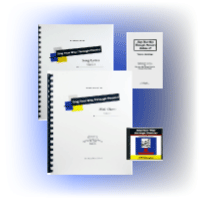





Plural Nouns and “-es” Word Endings Lesson Plan
More Than One
- Students will learn the spelling rule for adding the letters es to plural nouns.
- Students will learn the spelling rule for adding the letters es to verbs.
There are two instances of language arts word endings in which the letter s is added to the spelling of root words: 1. We add the suffix s to nouns when we wish to indicate more than one of something (spelling rules for plural form of words), and 2. We add the suffix s to verbs so that they will agree with the subject of the sentence (spelling rules for subject/verb agreement). In the first case, we change a noun from singular to plural when we convert the word dog to dogs or the word cat to cats. In the second case, we add the letter s to verbs that are used with a third person subjects like he, she, it, or nouns that can replace these pronouns. Examples: He jumps, she hops, it swims, Johnny skips, the dog barks. These general rules, however, do not apply to all nouns and verbs. There are some cases in which the letters es must be used instead of the letter s when forming plurals (Example: foxes) or third person verbs (Example: he pitches). Notice that when we pronounce the words foxes and pitches, the letters es form a separate syllable. In the song More Than One (from Sing Your Way Through Phonics, Vol. 2), students learn that if a word ends with the letters s, f, x, sh, ch, or z, we must first add the letter e before adding the letter s. The song gives students practice in forming plurals and verbs that require es endings and is an important part of the sequence of study targeting prefix and suffix activities for word recognition. For additional activities with prefixes, roots, and suffixes, see Hats and Boots in Sing Your Way Through Phonics, Vol. 3. In addition to young readers and writers, ESL students will find this song helpful in mastering the rules for plurals and verb endings in English.
- Sing Your Way Through Phonics Volume 2 CD, Tracks 19 and 20 (Listen to audio sample)
- Sing Your Way Through Phonics Volume 2 Mini-Charts (pp. 85-102)
- Index cards with one word printed on each card: buses, kisses, messes, glasses, dresses, calves, halves, hooves, elves, thieves, foxes, fixes, mixes, faxes, boxes, crashes, wishes, brushes, flashes, dishes, peaches, watches, churches, lunches, munches, buzzes, fizzes, frizzes, razzes, jazzes
- (Optional) Box or bucket and crumpled piece of notebook paper
Note: If you do not have the CD or Mini-Charts, you can still teach this plural nouns and e-s endings lesson plan using the folk tune listed on the More Than One Song Lyrics page. You can create your own mini-charts using the words in bold print letters in each verse of the Song Lyrics.
Find out more about Sing Your Way Through Phonics products.
Order our cost-saving Volume 2 Combo online.
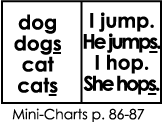
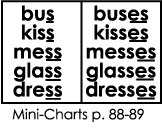


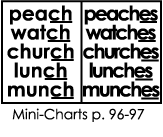


- Say, “Today we are going to learn a song that will help us with our spelling.” Turn to Mini-Charts p. 86 and point to the words dog and dogs. Ask, “If we want to write about more than one dog, what letter do we need to add to the word?” (s) Point to the words cat and cats. “If we want to write about more than one cat, what letter do we need to add to the word cat?” (s)
- Ask, “Which words on this page are singular?” (dog, cat) “What does singular mean?” (one of something) “Which words on this page are plural?” (dogs, cats) “What does plural mean?” (more than one of something) “What letter do we usually add when changing from singular to plural?” (s) Say, “But there are some words where we don’t just add the letter s to make plurals. In this song, we are going to learn about words where we need to add the letters e and s to form plurals.”
- Say, “There is another case where we usually add the letter s. That is when we use an action word with the words he, she, or it.” Point to Mini-Charts p. 87 and ask, “What happens to the action word jump when we change the sentence from I jump to He jumps?” (add the letter s) “What happens to the action word hop when we change the sentence from I hop to She hops?” (add the letter s) Say, “This song will also teach us when we have to add the letters e-s to action words when used with the words he or she.”
- Say, “Let’s listen to the song and when it’s over, I’ll ask you when we will be using the e-s ending instead of the s ending for plurals and action words.” Play Track 19 of Sing Your Way Through Phonics Vol. 2 while pointing to the Mini-Charts pp. 86-102.
- With Mini-Charts p. 102 displayed, ask, “How can we know when to use e-s endings for plurals and action words?” (when the word ends with s, f, x, sh, ch, or z) Practice saying these letters rapidly, as in the last refrain of the song. Say, “Let’s look at the examples for each of these word endings.”
- Point to Mini-Charts pp. 88. Ask, “What is the last letter in each of these words?” (s) Together, read the words across the two-page spread (i.e., bus, buses, kiss, kisses...)
- Repeat Step 6 with Mini-Charts pp. 92-99. Before reading p.98, ask, “Who knows what the word frizzes means in the sentence, ‘Sally’s hair frizzes in the rain’?” (gets curly and sticks out) “Who knows what the word razzes means in the sentence, ‘My brother always razzes me when I make a mistake’?” (teases) “Who knows what the word jazzes means in the sentence, ‘I like the way that singer jazzes up the song’?” (changes something in a fancy or fun way)
- Turn to Mini-Charts pp. 90-91. Ask, “What is the last letter in each of these words?” (f) Together, read the words across the two pages. Ask, “When words end with the letter f, what do we need to do before adding the letters e-s?” (change the f to v)
- Play Track 19 of Sing Your Way Through Phonics Vol. 2 and ask students to join in the singing. Allow two students to point to the Mini-Charts words while the song is being sung. (Students should point to each line on the left and right pages simultaneously.)
- To review, say, “So why do we usually add the letter s or e-s to some words?” (to mean more than one or to change an action word after he or she)
- Say, “Without looking at Mini-Charts p. 102, let’s see if you can name all the word endings that need e-s, rather than just s for plurals or action words.” (s, f, x, sh, ch, z) Give students a few chances to try this until the list is mastered by memory. Remind the students that if the word ends in the letter f, it must first be changed to the letter v before adding e-s .

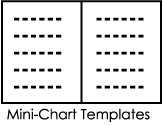
- Practice singing More Than One daily for a few days. Review the rules adding s or e-s to root words. (to mean more than one or to change an action word after he or she) Review the word endings where e-s will be used. (if root word ends in s, f, x, sh, ch, or z) Say, “The words leaf, half, and calf are examples of words that change spelling when they are plural by changing the f to v before adding e-s. There are some words that end in the letter f that do not follow this rule. Can you think of any examples?” (stuff/stuffs, cuff/cuffs, chief/chiefs)
- Turn to Mini-Charts. pp. 94-95. Say, “In addition to the words he or she, we also add s or e-s endings for action words when used with a singular word subject like boy, ball, or car, or when used with someone’s name like Johnny.” Using each of the words on these pages, ask students to supply examples of sentences with subjects other than the words he or she. (Examples: The car crashes into the wall; The boy wishes he had a new bike; Mom brushes the dog; The runner flashes by; Jenny dishes out ice cream to the customers.
- Using the Mini-Chart Templates, help students substitute other root word and plural sets of rule-following words in the song. Examples: pp. 88-89 pass/passes, floss/flosses, gas/gases, fuss/fusses, miss/misses; pp. 90-91 life/lives, wife/wives, shelf/shelves, staff/staves, scarf/scarves; pp. 92-93 tax/taxes, ax/axes, lynx/lynxes, jinx/jinxes, annex/annexes; pp. 94-95 splash/splashes, dash/dashes, push/pushes, bush/bushes, marsh/marshes; pp. 96-97porch/porches, torch/torches, perch/perches, march/marches, arch/arches, pp. 98-99 waltz/waltzes, topaz/topazes, spritz/spritzes, Spitz, Spitzes [a breed of dog], klutz/klutzes. Sing the song using these new examples with the instrumental track (Track 20) of More Than One.

- Play E-S Trash-Ball: Divide the class into two teams. Using index cards on which the song’s words are printed (see Materials list above), students from each team alternate turns, spelling the word on each card as it is drawn. If spelled correctly, the student has a chance to earn a point for his/her team by shooting the crumpled paper into a bucket or box. No points are lost if the bucket is missed. If a word is spelled incorrectly, the word is shown to the class and replaced in the middle of the deck. After all cards have been used, the team with the highest points wins. To avoid stress, any speller can ask for help from one other student. To make the game more interesting, add cards labeled Skip a Turn, Extra Turn, and Extra Throw.
- Create a one-sentence poems with words that have rhyming es endings. Examples: Ten furry foxes jumped over boxes. He munches on bunches of carrots with crunches.
- Students will pass a spelling test using the words on Mini-Charts pp. 89, 91, 93, 95, 97, and 99.
- Students will correctly spell words that require es endings in their daily journal writing.
